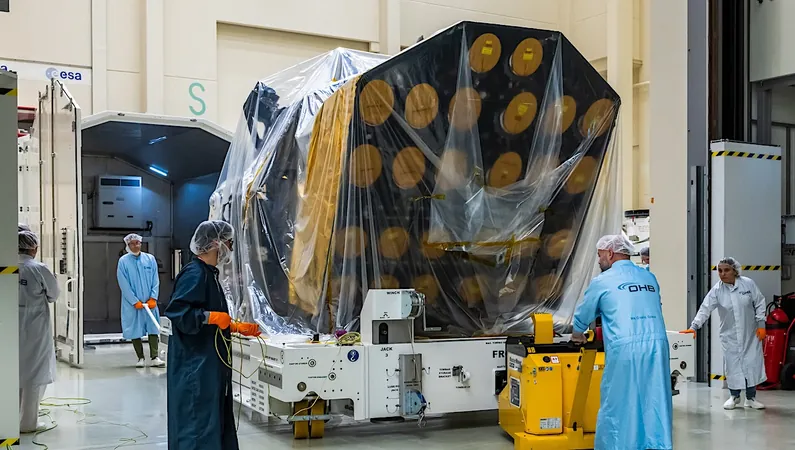
Plato Telescope Embarks on Planet-Hunting Adventure!
2025-09-12
Author: Wei Ling
The Arrival of Plato: A New Era in Planet Discovery
Exciting times are here! The European Space Agency's ambitious Plato spacecraft has officially landed at ESTEC, the bustling hub of ESA operations in the Netherlands. This is the gateway for engineers to finalize its assembly and prepare for an electrifying mission that could unveil new worlds beyond our own.
What’s Next for Plato?
Fresh off its journey from Germany, where its two main components were seamlessly joined, Plato is now situated in a special cleanroom. Over the next few weeks, engineers will attach the spacecraft's sunshield and solar arrays. But that’s just the beginning!
Once all parts are connected, the real action begins. Plato will endure rigorous vibration tests designed to simulate the turbulent conditions of a launch, accompanied by intense acoustic tests that will ensure it can withstand the raucous sounds of liftoff.
Testing the Limits: Can Plato Survive Space?
Following these trials, the spacecraft will enter the Large Space Simulator—Europe’s titan of vacuum chambers. Here, it will be subjected to extreme temperatures that mimic the harsh conditions of outer space, ensuring it’s ready for its mission.
Plato's Mission: Searching for Earth-like Worlds!
Scheduled to launch aboard an Ariane 6 rocket in December 2026, Plato is on a quest to find Earth-like planets orbiting stars similar to our Sun. Equipped with 26 ultra-sensitive cameras, Plato looks for the subtle dimming of starlight caused by planets passing in front of their host stars.
Its focus? Discovering planets that exist in the 'habitable zone'—the ideal Goldilocks region where conditions are just right for liquid water to exist. These planets will be monitored over at least two years as they orbit their stars, providing invaluable data for scientists.
Unlocking the Secrets of the Universe!
But that's not all! Plato will also help scientists study 'starquakes'—tiny fluctuations in a star’s brightness, unlocking secrets about the very nature of stars themselves. It will observe more than 200,000 stars from its orbital perch at the Sun-Earth Lagrange point 2, a staggering 1.5 million kilometers from Earth.
A Collaboration for the Cosmos!
Plato isn’t just a solo venture; it’s the brainchild of a collaborative effort between ESA and the Plato Mission Consortium, comprised of various European research institutions and industries, spearheaded by the German Aerospace Center (DLR). The craftsmanship of this groundbreaking telescope is being handled by the industrial Plato Core Team, with contributions from OHB, Thales Alenia Space, and Beyond Gravity.
Why This Matters!
As Plato prepares for its shining moment, it promises to deepen our understanding of the cosmos—revealing whether the perfect conditions for life, like those we enjoy on Earth, could exist elsewhere in our galaxy. The adventure is just beginning!



 Brasil (PT)
Brasil (PT)
 Canada (EN)
Canada (EN)
 Chile (ES)
Chile (ES)
 Česko (CS)
Česko (CS)
 대한민국 (KO)
대한민국 (KO)
 España (ES)
España (ES)
 France (FR)
France (FR)
 Hong Kong (EN)
Hong Kong (EN)
 Italia (IT)
Italia (IT)
 日本 (JA)
日本 (JA)
 Magyarország (HU)
Magyarország (HU)
 Norge (NO)
Norge (NO)
 Polska (PL)
Polska (PL)
 Schweiz (DE)
Schweiz (DE)
 Singapore (EN)
Singapore (EN)
 Sverige (SV)
Sverige (SV)
 Suomi (FI)
Suomi (FI)
 Türkiye (TR)
Türkiye (TR)
 الإمارات العربية المتحدة (AR)
الإمارات العربية المتحدة (AR)